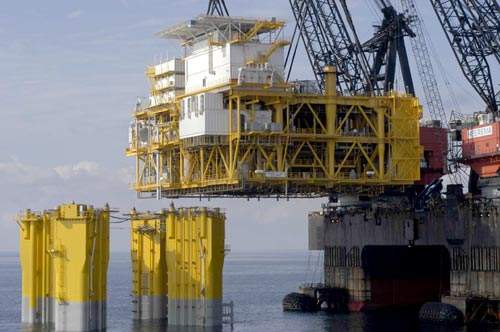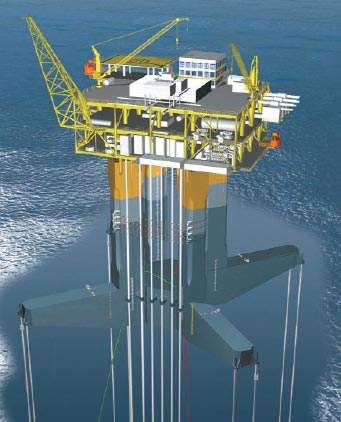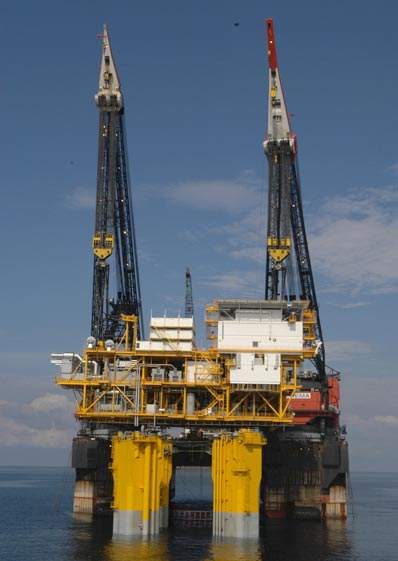The Marco Polo field is located in Green Canyon block 608, 160 miles south of New Orleans. It is fully owned and operated by Anadarko Petroleum. The field was discovered in April 2000 and lies in water 4,300ft deep. It produced its first oil in March 2004. The field is drained by six delineation wells with an average net pay of 292ft. It is expected to produce approximately 50,000 barrels of oil and 150 million ft³ of gas per day.
TENSION LEG PLATFORM (TLP)
The field is being developed by the world’s deepest water Tension Leg Platform (TLP) which is owned by Deepwater Gateway, a 50/50 joint venture company between GulfTerra Energy Partners and Cal Dive International. This Moses TLP is designed by MODEC International and Sea Engineering.
The hull was fabricated at the Samsung Heavy Industries Yard SHI Koji Island, South Korea. The first steel was cut in July 2002 and it was loaded out in June 2003. The hull travelled 13,000 miles and arrived in Texas in August 2003. It was installed that November.
The hull has a weight of 11,500kips (5,750t) and a 55,000kip (27,500t) displacement. Its payload is 28,000kips (14,000t) and it has a width (tip to tip) of 344ft. The height from the bottom of the base to the top of the column is 196ft although it has a draft of 129ft when operating normally.
The hull supports topsides over three deck levels. Designed by Alliance Engineering and constructed in Corpus Christi, it weighs 6,300t (lift weight) or 7,250t (operating weight). It can accommodate 26 people in its quarters. The processing capacity is 120,000 barrels of oil and 300 million ft³ of gas per day. Well operations are carried out by a 1,200hp work-over rig. The platform is classified by ABS.
The platform has six dual casing production risers as well as two export pipeline steel catenary risers (12.75in and 18in). In addition, there are six pre-installed I-tubes for umbilicals and provision for 12 (future) flowline risers.
The TLP is anchored to the seabed by eight 28in-diameter tendons with a 1.2in wall thickness. The tendons are secured to the seabed by piles measuring 390ft with a 76in diameter. They have a wall thickness of up to 2in.
OIL AND GAS PIPELINES
The oil and gas are exported by a pipeline system owned by GulfTerra. The gas pipeline extends approximately 75 miles from Green Canyon 608 to Green Canyon 236 (with a water depth of 1,750ft). There is a subsea interconnect with the GulfTerra-owned Typhoon gas pipeline, where the two form the Anaconda Gathering System. The capacity of Anaconda is 320 million ft³ of gas, expandable to 430 million ft³.
The oil pipeline runs approximately 36 miles to Green Canyon 164 (where the water depth is 2,800ft). The 12.75in steel catenary riser and 14in pipeline leads to the subsea interconnect with the GulfTerra-owned Allegheny oil pipeline. This has a capacity of 120,000 barrrels/day of oil. It then connects with the Poseidon Oil Pipeline system (36% owned and operated by GulfTerra) and the Cameron Highway Oil Pipeline System (50% owned and operated by GulfTerra) on the Ship Shoal 332 platform.
K2 FIELD TIED BACK TO MARCO POLO
The K2 field, located on Green Canyon Block 518 in the Gulf of Mexico, will also be tied back to the Marco Polo platform with first production expected in 2005. Anadarko has a 100% working interest in the block. The K2 North No. 2 well encountered a total of 165ft of net oil pay and increases the size of the K2 North discovery. It was spudded in December 2003 in 4,000ft of water and was drilled to a total depth of 29,180ft.












